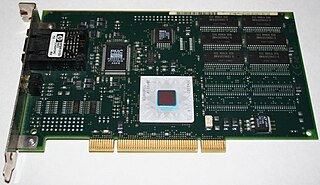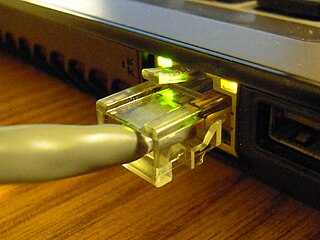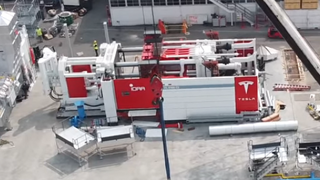
Asynchronous Transfer Mode (ATM) is a telecommunications standard defined by the American National Standards Institute and International Telecommunication Union Telecommunication Standardization Sector for digital transmission of multiple types of traffic. ATM was developed to meet the needs of the Broadband Integrated Services Digital Network as defined in the late 1980s, and designed to integrate telecommunication networks. It can handle both traditional high-throughput data traffic and real-time, low-latency content such as telephony (voice) and video. ATM provides functionality that uses features of circuit switching and packet switching networks by using asynchronous time-division multiplexing. ATM was seen in the 1990s as a competitor to Ethernet and networks carrying IP traffic as, unlike Ethernet, it was faster and designed with quality-of-service in mind, but it fell out of favor once Ethernet reached speeds of 1 gigabits per second.

Ethernet is a family of wired computer networking technologies commonly used in local area networks (LAN), metropolitan area networks (MAN) and wide area networks (WAN). It was commercially introduced in 1980 and first standardized in 1983 as IEEE 802.3. Ethernet has since been refined to support higher bit rates, a greater number of nodes, and longer link distances, but retains much backward compatibility. Over time, Ethernet has largely replaced competing wired LAN technologies such as Token Ring, FDDI and ARCNET.
Multiprotocol Label Switching (MPLS) is a routing technique in telecommunications networks that directs data from one node to the next based on labels rather than network addresses. Whereas network addresses identify endpoints, the labels identify established paths between endpoints. MPLS can encapsulate packets of various network protocols, hence the multiprotocol component of the name. MPLS supports a range of access technologies, including T1/E1, ATM, Frame Relay, and DSL.
Circuit switching is a method of implementing a telecommunications network in which two network nodes establish a dedicated communications channel (circuit) through the network before the nodes may communicate. The circuit guarantees the full bandwidth of the channel and remains connected for the duration of the communication session. The circuit functions as if the nodes were physically connected as with an electrical circuit.
In the seven-layer OSI model of computer networking, the physical layer or layer 1 is the first and lowest layer: the layer most closely associated with the physical connection between devices. The physical layer provides an electrical, mechanical, and procedural interface to the transmission medium. The shapes and properties of the electrical connectors, the frequencies to transmit on, the line code to use and similar low-level parameters, are specified by the physical layer.

Steering is the control of the direction of motion or the components that enable its control. Steering is achieved through various arrangements, among them ailerons for airplanes, rudders for boats, cylic tilting of rotors for helicopters, and many more.
Optical burst switching (OBS) is an optical networking technique that allows dynamic sub-wavelength switching of data. OBS is viewed as a compromise between the yet unfeasible full optical packet switching (OPS) and the mostly static optical circuit switching (OCS). It differs from these paradigms because OBS control information is sent separately in a reserved optical channel and in advance of the data payload. These control signals can then be processed electronically to allow the timely setup of an optical light path to transport the soon-to-arrive payload. This is known as delayed reservation.

A passive optical network (PON) is a fiber-optic telecommunications network that uses only unpowered devices to carry signals, as opposed to electronic equipment. In practice, PONs are typically used for the last mile between Internet service providers (ISP) and their customers. In this use, a PON has a point-to-multipoint topology in which an ISP uses a single device to serve many end-user sites using a system such as 10G-PON or GPON. In this one-to-many topology, a single fiber serving many sites branches into multiple fibers through a passive splitter, and those fibers can each serve multiple sites through further splitters. The light from the ISP is divided through the splitters to reach all the customer sites, and light from the customer sites is combined into the single fiber. Many fiber ISPs prefer this system.

Industrial Ethernet (IE) is the use of Ethernet in an industrial environment with protocols that provide determinism and real-time control. Protocols for industrial Ethernet include EtherCAT, EtherNet/IP, PROFINET, POWERLINK, SERCOS III, CC-Link IE, and Modbus TCP. Many industrial Ethernet protocols use a modified media access control (MAC) layer to provide low latency and determinism. Some microprocessors provide industrial Ethernet support.

A computer network is a set of computers sharing resources located on or provided by network nodes. Computers use common communication protocols over digital interconnections to communicate with each other. These interconnections are made up of telecommunication network technologies based on physically wired, optical, and wireless radio-frequency methods that may be arranged in a variety of network topologies.

Tesla, Inc. is an American multinational automotive and clean energy company. Headquartered in Austin, Texas, it designs, manufactures and sells battery electric vehicles (BEVs), stationary battery energy storage devices from home to grid-scale, solar panels and solar shingles, and related products and services.
DeviceNet is a network protocol used in the automation industry to interconnect control devices for data exchange. It utilizes the Common Industrial Protocol over a Controller Area Network media layer and defines an application layer to cover a range of device profiles. Typical applications include information exchange, safety devices, and large I/O control networks.
Etherloop is a hybrid technology combining aspects of Ethernet with other technologies to achieve a result not possible with either technology alone. EtherLoop was originally developed in the 1990s to allow high-speed data communication access to residential customers over standard twisted-pair telephone lines, also known as plain old telephone service or POTS. The technology development effort was begun at Northern Telecom in order to allow telephone companies to compete with the high-speed local data access then beginning to be offered by cable TV providers.
In automobiles, a 42-volt electrical system was an electrical power standard proposed in the late 1990s. It was intended to facilitate increasingly-powerful electrically-driven accessories in automobiles, and lighter wiring harnesses. Electric motors were proposed to be used for power steering or other systems, providing more compact installations and eliminating the weight of drive belts or large wires for high-current loads.

An optical mesh network is a type of optical telecommunications network employing wired fiber-optic communication or wireless free-space optical communication in a mesh network architecture.

The Tesla Semi is a battery electric semi-trailer truck built by Tesla, Inc. since 2022. The truck is powered by three motors, and according to Tesla has approximately three times the power of a typical diesel semi truck, a range of 500 miles (800 km), and can operate at an energy use of less than two kilowatt-hours per mile (1.2 kW⋅h/km).

The Tesla Cybertruck is a battery electric pickup truck built by Tesla, Inc. since 2023. Introduced as a concept vehicle in November 2019, it has a controversial body design reminiscent of low-polygon modelling, consisting of flat stainless steel sheet panels.

The Giga Press program is a series of aluminium die casting machines manufactured for Tesla, initially by Idra Group in Italy. Idra presses were the largest high-pressure die casting machines in production as of 2020, with a clamping force of 55,000 to 61,000 kilonewtons. Each machine weighs 410–430 tonnes (900,000–950,000 lb).

Gigafactory Texas is a Tesla, Inc. automotive manufacturing facility in unincorporated Travis County, Texas, just outside of Austin. Construction began in July 2020, limited production of Model Y began before the end of 2021, and initial deliveries of vehicles built at the factory took place at an opening party called "Cyber Rodeo" on April 7, 2022.
Tesla Powershare is a "bi-directional charging" technology with the ability to supply power to a load from a Tesla vehicle. Potential loads include electrical tools and appliances, another Tesla or non-Tesla vehicle, and/or a home/building. As of December 2023, Powershare is available only via Tesla Cybertruck. Similar facilities are available from automakers such as Ford, General Motors, and Kia.











